Few fittings on a sailing yacht are as universally used—and as quietly reliable—as the D shackle. From connecting blocks and halyards to securing anchors and standing rigging components, D shackles are found throughout the boat. Their simple, efficient geometry has changed little over centuries of maritime evolution, yet today’s designs incorporate refined materials, precision manufacturing and enhanced locking mechanisms that make them stronger, lighter and safer than ever.
Origins and Purpose of D Shackles
The D shackle takes its name from its shape: a compact, semi-circular body with a straight pin forming a letter “D.” This geometry provides excellent load alignment when forces act in line with the pin, making it ideal for most static or lightly articulating connections onboard.
Historically, shackles developed from simple iron links and rings used on sailing ships of the 18th and 19th centuries. As wire rope and steel fittings replaced hemp and wood, riggers needed reliable detachable links—and the D shackle was born. Its compact form allows it to fit into tight spaces and handle high loads without twisting, which explains its enduring popularity on modern yachts, whether traditional or high-tech composite builds.
Materials and Construction of Marine D Shackles
Marine-grade D shackles are typically made from stainless steel or, in high-load racing applications, titanium or forged alloy steel.
- 316 stainless steel is the most common choice for cruising yachts: corrosion-resistant, strong, and visually smart.
- High-tensile or forged stainless variants offer increased Working Load Limits (WLL) for similar size and weight.
- Titanium D shackles provide the ultimate strength-to-weight ratio and are favoured on performance multihulls and superyachts where weight savings justify the cost.
Modern manufacturing tolerances ensure that pin threads, shoulders, and bows are precisely aligned, reducing risk of fatigue or point loading—critical when D shackles are cycled under load in running rigging.
Understanding the Different Styles of D Shackles
D shackles come in several body styles, each optimised for a slightly different application.
Standard D Shackles – The most common pattern, with a straight-sided “D” profile. Best suited for inline loads such as halyard terminals, blocks, and chainplates.
Wide D Shackles – Feature a larger internal width, allowing connection of two fittings side-by-side (for example, a block and a rope thimble). The trade-off is reduced ultimate strength due to the wider bow.
Short D Shackles – More compact than standard types, used where space is restricted or minimal movement is desired. Often found on deck hardware or fittings close to the mast base.
Long D Shackles – Offer greater articulation or clearance between components. Useful for connecting gear that must pivot freely, such as traveller cars or boom fittings.
Twisted D Shackles – Incorporate a 90-degree twist between the pin and the body. This allows connection between two fittings set at right angles—for instance, linking a horizontally oriented deck eye to a vertically loaded block.
Understanding these subtle geometry differences helps avoid side-loading, which is one of the main causes of premature failure in rigging attachments.
Pin and Closure Types for D Shackles
The pin system determines how secure and convenient a D shackle is to use. While traditional threaded pins remain standard, there are several engineered closure options:
- Screw-pin D shackles – The classic configuration. Reliable and simple, but the pin can work loose under vibration unless seized with wire or thread-locker.
- Captive-pin D shackles – The pin remains attached to the shackle body when opened, preventing accidental loss. Particularly useful aloft or in confined spaces.
- Self-locking D shackles – Incorporate an internal spring or secondary locking mechanism, eliminating the need for seizing wire. Ideal for running rigging connections where frequent removal is required.
- Allen-head D shackles – Designed for a flush finish, tightened using an Allen key. Common on modern race yachts where snag-free deck layouts and tamper resistance are priorities.
- Bolt-type or safety-bolt D shackles – Feature a cross-hole and split pin, offering maximum security for standing rigging or high-load static connections such as forestay attachments.
Selecting the correct pin type is often a balance between convenience and security: cruising sailors may prioritise ease of use, whereas offshore racers prefer tamper-proof designs that stay locked under dynamic loads.
Wichard Key Pîn D Shackle
Choosing the Right D Shackle for Your Application
When specifying a D shackle, key parameters include Safe Working Load (SWL) or Working Load Limit (WLL), pin diameter, and internal dimensions. Always ensure that the load direction aligns with the pin axis and that the shackle body is not distorted by oversized fittings. In dynamic applications, a safety factor of at least 5:1 is typically recommended, and higher where shock loads are expected.
Routine inspection is essential: look for thread galling, distortion, or corrosion pitting. A seized or bent D shackle should always be replaced, not re-used.
The Modern Evolution of D Shackles
Even as synthetic rigging and soft attachments such as Dyneema® loops become more common, D shackles remain indispensable. In many cases, they provide the fixed, reliable connection point that soft loops still require—particularly where precise alignment or metal-to-metal contact is necessary. Modern engineering has refined rather than replaced them: lighter materials, improved coatings, and captive pin systems continue to evolve this deceptively simple piece of hardware.
Conclusion: Why D Shackles Still Matter
Whether securing your anchor chain, connecting a halyard block, or mounting a deck fitting, the D shackle remains one of sailing’s most dependable components. Its enduring design balances simplicity with strength, adaptability with precision.
For a full selection of standard, wide, short, long, and twisted D shackles—including self-locking, captive, and Allen-head options—explore our full range here:
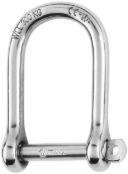
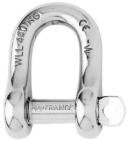
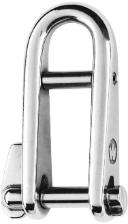
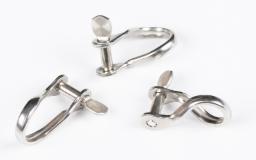
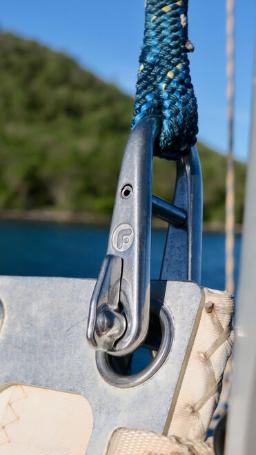


D Shackles: The Unsung Workhorse of Modern Rigging